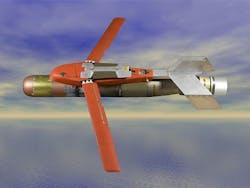Boeing moves forward with flying torpedo high-altitude ASW attack system for P-8A aircraft
Officials of the Naval Air Systems Command at Patuxent River Naval Air Station, Md., announced a $23.2 million contract this week to the Boeing Defense, Space & Security segment in Seattle for testing of the High Altitude Anti-Submarine Warfare Weapon Capability (HAAWC) for the P-8A.
HAAWC anti-submarine warfare (ASW) technology involves Boeing-built add-on kits for the U.S. Navy Mark 54 lightweight torpedo called the HAAWC Air Launch Accessory (ALA) that will enable the weapon to glide through the air from altitudes as high as 30,000 feet and enable the Boeing P-8A to attack enemy submarines from long ranges.
The HAAWC ALA turns the Raytheon Mark 54 torpedo into a glide weapon that the P-8A aircraft can release from high altitudes. As the flying torpedo reaches the water, it jettisons wings and other air-control surfaces and takes on its original role as a smart torpedo that detect, track, and attack enemy submarines autonomously.
It is unlikely that a submerged submarine could detect the presence of a P-8A flying as high as 30,000 feet. The only warning the enemy sub would have is the sound of the HAAWC torpedo entering the water close by. The Navy selected Boeing to develop the HAAWC ALA flying torpedo high-altitude ASW system for the P-3A Poseidon in April 2013.
The Mark 54 always has been able to be launched from fixed-wing aircraft and helicopters, but before the HAAWC add-on kit air crews had to release the torpedo from altitudes no higher than about 100 feet.
The HAAWC will enable the P-8A aircraft -- a Boeing 737 passenger jetliner modified for maritime patrol -- to maintain optimum surveillance altitudes without wasting the time and fuel necessary to drop to low altitudes to attack targets and then climb back to high patrol altitudes.
Attacking from high altitudes also enables the P-8A to reduce the time between target acquisition and attack, as well as launch anti-submarine weapons outside the ranges of shore-based anti-aircraft defenses.
When launched from 30,000 feet the HAAWC-equipped Mark 54 torpedo will glide for seven to 10 minutes before entering the water. The system uses technologies that Boeing developed originally for the Joint Direct Attack Munition (JDAM) and Small Diameter Bomb (SDB) so it can be launched from high altitudes and far from targets, Boeing officials say.
Related: Navy makes plans to order 29 new P-8A Poseidon maritime patrol jets for U.S. and Australia
While in flight the HAAWC will be completely self-contained. The HAAWC adaptor kit includes a flight control computer, a GPS-based navigation system, and power sources. When near the water the system sheds its wings and activates a parachute that lowers the torpedo to the water to begin its run toward the target.
The Boeing HAAWC add-on kit requires little or no modifications to the Mark 54 torpedo or to the P-8A Poseidon maritime patrol aircraft. The Mk 54 is an all-digital lightweight torpedo that has advanced software algorithms from the larger submarine-launched Mark 48 torpedo.
On this contract Boeing will do the work at Patuxent River Naval Air Station, Md., and in Seattle, and should be finished by August 2017. For more information contact Boeing Defense, Space & Security online at www.boeing.com/defense, or Naval Air Systems Command at www.navair.navy.mil.
